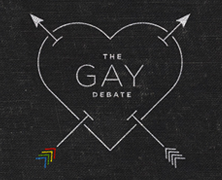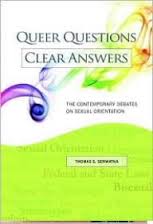Peter Sprigg, a Senior Research Fellow for Policy Studies at Family Research Council, has provided the content that forms the basis of this Thinker Education course. His short work entitled Debating Homosexuality: Understanding Two Views is excerpted in the following sessions, with added video content and resources and commentary from our curriculum team.
——-
In recent years, activists pushing for a “gay rights” political agenda, such as the legalization of same-sex marriage and the overturning of the law against open homosexuality in the military, have become increasingly virulent in their attacks upon social conservatives who oppose that agenda. Examples of these attacks include a federal judge declaring that the passage of California’s Proposition 8 in 2008 could only have been motivated by hostility toward gay and lesbian individuals,[i] and the 2010 announcement by the Southern Poverty Law Center that it classifies several pro-family organizations as “anti-gay hate groups.”[ii]
Such attacks reveal a fundamental misunderstanding (if not deliberate misrepresentation) of the beliefs, arguments, and motives of social conservatives. This misunderstanding arises from the existence of two completely different paradigms, or fundamental ways of understanding the nature of homosexuality.
The “Gay Identity” Paradigm
Gay activist groups, and a growing portion of major social institutions such as academia and the news media, have come to adopt a view of homosexuality one might call the “gay identity” paradigm. The foundations of the “gay identity” paradigm are these beliefs:
- Sexual orientation is an innate personal characteristic, like race.
- People are born gay.
- Gay people can never become heterosexual.
- Being gay is essentially no different from being straight, except for the gender to which one is sexually attracted.
- There is no harm in being gay.
Based on these beliefs (or, in many cases, unspoken presuppositions), gay activist groups declare, and some others have come to accept, that for someone to believe that heterosexuality is preferable to homosexuality is equivalent to believing that one race is superior to another, and therefore represents a form of bigotry and even “hate” toward gays and lesbians as individuals.
However, this conclusion about critics of homosexuality cannot be valid unless the presuppositions of the “gay identity” paradigm are empirically true, and it is not logical unless social conservatives are operating from the same paradigm.
In reality, the empirical case for the “gay identity” paradigm is extremely weak and is, in any case, subject to legitimate debate. Furthermore, what is beyond dispute is that social conservatives do not view homosexuality from the perspective of the “gay identity” paradigm. Therefore, it is not only unfair and misguided, but it is simply illogical to impugn the motives of social conservatives based on that paradigm.
That does not mean that how our culture views the homosexual agenda is not changing, however. It is changing, and quite rapidly. Consider this promotion from an LGBTQ activist (viewer discretion advised) of the last forty years of “progress” as he describes it, including reference to the “coming out” phenomena that has been prevalent in recent years as in Ancient Rome and other times in history:
What Is “Sexual Orientation?”
To deconstruct the “gay identity” paradigm, and understand the alternative view which drives social conservatives, it is necessary to examine the actual nature of “sexual orientation.” Too often, it is assumed that “sexual orientation” is a unitary phenomenon whose meaning is clear. This is not the case.
As all serious researchers in human sexuality understand, “sexual orientation” is an umbrella term for three quite different things. The first of these is one’s sexual attractions – is a person sexually attracted to people of the opposite sex, the same sex, or both? The second element of sexual orientation is sexual conduct – what sex acts does an individual choose to engage in, and with whom? The third element of sexual orientation is sexual self-identification – does an individual think of himself or herself, and/or publically identify himself or herself to others, as “gay,” “lesbian,” “straight,” or bisexual?”
The “gay identity” paradigm assumes that these aspects of “sexual orientation” will always be consistent with one another – that is, that a person with same-sex attractions will also engage exclusively in homosexual conduct and publically self-identify as “gay.”
However, scientific research into human sexuality has clearly shown that this is not always the case.[iii] Some people experience same-sex attractions, but do not choose to engage in homosexual conduct (or choose to engage in heterosexual conduct instead). Some people experience same-sex attractions and engage in homosexual conduct, but do not self-identify as “gay.” It has been observed that in unique situations (such as prisons), people who neither experience same-sex attractions nor self-identify as gay may nevertheless choose to engage in homosexual conduct. Therefore, any meaningful discussion of the topic of homosexuality requires that the three elements of sexual orientation be addressed individually.
A “Homosexual Conduct” Paradigm
The “gay identity” paradigm is simplistic, since it is based on the assumption (which the research clearly shows to be false) that “sexual orientation” is a unitary characteristic. Under this view, people are either gay or not gay, so to criticize homosexuality is to denigrate some people for “who they are.”
Social conservatives approach the topic of homosexuality using a completely different paradigm – one that is more sophisticated, and more consistent with the research on human sexuality and sexual orientation, than the “gay identity” paradigm. This paradigm is based on the reality that same-sex attractions, homosexual conduct, and self-identification as “gay” are three separate (although related) matters which must be addressed separately.
For social conservatives, particularly when it comes to public policy debates related to homosexuality, homosexual conduct is by far the most important of the three elements of sexual orientation. Hence, we might refer to the social conservative approach to the issue of homosexuality as a “homosexual conduct” paradigm, in contrast to the “gay identity” paradigm.
Understanding these two divergent paradigms is crucial to accurately understanding the position of social conservatives on the issue of homosexuality. Social conservatives do not believe or argue that “gay people are inferior,” as gay activists charge. What they believe and argue is that homosexual conduct is harmful – first and foremost to the people who engage in it, but also by extension to society at large.
Gay activists, and others who have accepted the “gay identity” paradigm, argue that the public policy debates revolve around whether “gay people are treated equally” to straight people. Social conservatives perceive the issues at stake completely differently. They believe, without question, that gay people, as individuals, should and do enjoy all the same rights under the Constitution and its Bill of Rights as any other American. However, social conservatives perceive the key issue in public policy debates as being whether homosexual conduct and homosexual relationships should be discouraged; treated as entirely private (that is, neither discouraged nor affirmed); or actively protected, affirmed, and celebrated. The latter is what gay activists demand.
[i] Perry et al. v. Schwarzenegger et al., 704 F. Supp, 2d 921 (2010). Judge Vaughn Walker wrote, “The evidence shows conclusively that Proposition 8 enacts, without reason, a private moral view that same-sex couples are inferior to opposite-sex couples,” and then cited the 1996 Supreme Court case of Romer v. Evans (517 U.S. 620): “[L]aws of the kind now before us raise the inevitable inference that the disadvantage imposed is born of animosity toward the class of persons affected.”
[ii] Evelyn Schlatter, “18 Anti-Gay Groups and Their Propaganda,” Intelligence Report (Southern Poverty Law Center), Winter 2010, Issue 140; online at: http://splcenter.org/get-informed/intelligence-report/browse-all-issues/2010/winter/the-hard-liners.
[iii] See Edward O. Laumann, John H. Gagnon, Robert T. Michael, and Stuart Michaels, The Social Organization of Sexuality: Sexual Practices in the United States (Chicago: University of Chicago Press, 1994), pp. 283-320.









